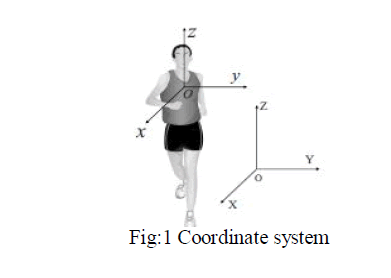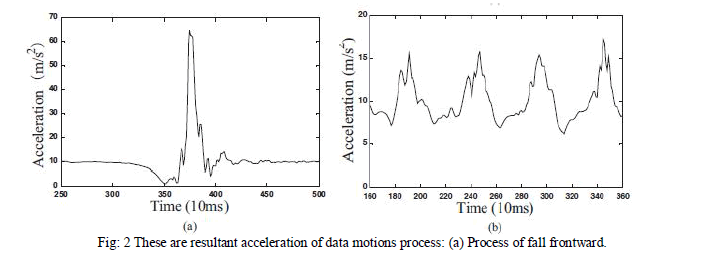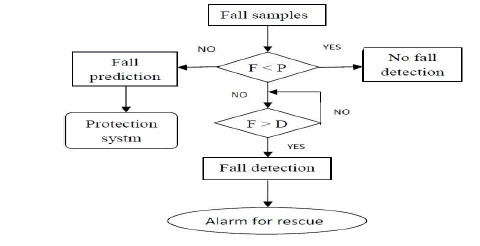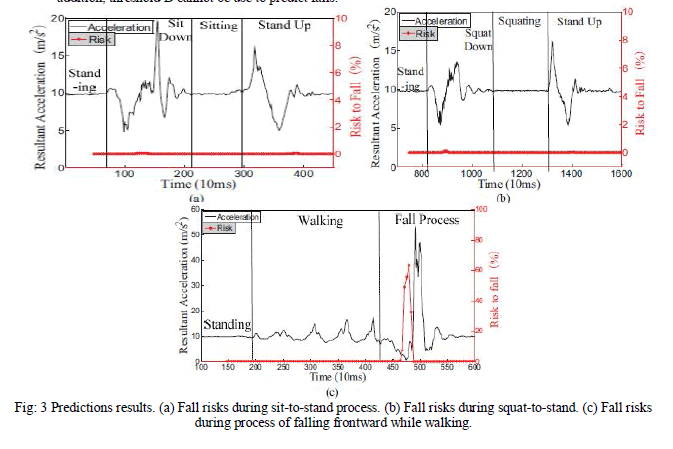ISSN ONLINE(2320-9801) PRINT (2320-9798)
ISSN ONLINE(2320-9801) PRINT (2320-9798)
| G.N.Swathi M.Amarnadh Dept. of ECE, SIETK, Puttur, Chittor, AP, India |
| Related article at Pubmed, Scholar Google |
Visit for more related articles at International Journal of Innovative Research in Computer and Communication Engineering
Falls in the elderly have sometimes been serious medical and social problems. For this problem, by using of tri-axial accelerometer we can detect and prevents a patient from fall down when he/she is unconsciousness. This can detect and predict falls based on tri-axial acceleration of human heap and shoulder level. The acceleration time series extracted from human motion processes are use to describe human motions like walking, running etc are set up by using a support vector machine; it will classify falls and other normal motions. This output is connecting to ADC, it will convert analog to digital signal and then this digital signal is gives to the microcontroller. If any abnormal condition will occurs in any region, a smart mechanical airbag will allows enough time for compressed air to release so airbag will be open before a person falls to the ground. At the same time, this information will be send to a registered phone number via GSM Technology and we can identify the position of the user by GPS.
KEYWORDS |
| Tri-accelerometer, Detection, Prediction, Support Vector Machine (SVM), ADC, GSM and GPS Technology. |
I. INTRODUCTION |
| Now-a-days increases aging population is one of the major social problems. So many problems are causes by aging, if we concentrate on beginning to end approximately 33% old peoples are falling and remaining problems are causes by injuries and fire fighting [2]. This fall and fall-induced fractures are very common problem to who suffer by frail and dependent. Hip fractures account for most of the deaths and costs associated with fall-induced fractures. Many hip protectors calm and controlled of a pair of hard pads suffering from wear with a tight undergarment are commercially available. The elderly find such protectors uncomfortable and inconvenient. They do not deliver to the hip fracture prevention qualities expected from them, but they have poor compliance rate. |
| Because, that may be relied on fall detection is great importance. These days’ falls are common problem, but they are difficult to describe exactly. Falls in the elderly have become a financial burden to family and society [3]. Therefore, reliable fall detection and prevention are essential in independent living facilities detect then prevent the heavy weight collision of a fall event detection undertake by immediately information will gives to helper by this way we can reduces the going to hospital [5]. |
| Technical advances in micro electro mechanical system (MEMS) sensors, microprocessors and wireless communication have been the driving a circumstance contributing to make easier result to monitoring of people’s physical activities. Comparing to this result, some wearable automatic sensor based fall detectors are developed. Some other author used a bi-axial gyroscope to detect fall events [4]. By using of bi-axial gyroscope fall detection and daily life, activities are the fully identified but there is no prediction solution. Now we are going developing the airbag system to overcome this problem. This airbag will protect hip when falling down or car accident suddenly [8],[9]. To make sure that air fully filled before a collision or fall down. When fall condition will occur its sets [6] tri-axial accelerometer and angular velocities thresholds using support vector machine (SVM) methods to predict fall events. |
| Without considered of angle calculation of acceleration method we can reduce the complexity of algorithm and it will improve fault tolerance. In these criteria of human motion, the accelerations vary real timely because of one’s own movements, touching with each others, touching with other objects and also gravity, and then make up acceleration time series (ATS) [7]. |
| This paper describes a reliable human fall detection and prediction method using tri-axial accelerometer, through examining in detail the features of human motion series during fall processes. First, obtain tri-axial acceleration at human shoulder level from fall processes and other daily life activities. Second, take out features that describe the movements during a series of short time periods by turns to make up ATS, this characterize motion processes. Finally, we set thresholds by compiling statistics of the results from different motion processes to detect and predict fall events. |
| By using this project, we can detect and prevents patient fall down when he/she get unconsciousness or accident suddenly. This is also use in the medical department and space. This information will be send to a registered phone number via GSM technology. |
II. METHODS AND SYSTEM SET UP |
| The relationships between human fall process and Acceleration time series (ATS), a tri-axial accelerometer based on the system as proportion of the body to collect acceleration in units of m/s² during human fall controlling a situation and other daily life activities. ATS take out to describe fall process from feature extracting especially up to the instant before the hit another object of collision. A random process mathematical model to describe fall process before hit another object. |
| A. System Design |
| The system board is designing with a 32-bit microprocessor, 12-bit ADC, an SD memory card and a USB interface and power is 9V battery. The sensor is tri-axial accelerometer produced by [1] free scale semi conductors; this can wear comfortably without disturbing the wearer’s daily life. This can be support to human body’s surface easily with size of 9 cm x 5.5 cm x 2 cm. |
| B. Sensor Location |
| The acceleration varies in different parts of human body during movements; the location of controller on human body surface is very important it is truly reflect the key features of human fall process. We can also place the controller on the arm, wrist, hip, and leg, but these places are not suitable positions for the accelerometer [6], [11]. They high movement frequency and complexity because of there are not suitable. Of course, they may be the more comfortable place to wear [10]. We have to place the upper trunk; this is below the neck and above waist. It is the most suitable feature region to get accuracy result from other movements using acceleration. |
| C. Information Acquisition |
 |
 |
 |
| (b) Process in walking. |
| The above Fig shows that the resultant of acceleration curves from each kind of motion processes that meant distinctions among all process. The curve in fig (a) shows that the biggest hit another object during this fall has exceed some gravity due to the collision between body and sponge mat and fig (b) shows that the acceleration of normal walk show some periodic features. |
| D. Fall prediction and detection algorithm |
| The threshold should take two demands into account, which is the prediction should be made as early as possible for taking protection and the detection should identify the falls effectively to reduce false alarm. So two thresholds are need that are one is P for fall prediction and second one is D for fall detection. First set the threshold P, which is determines by Support Vector Machine (SVM) to make prediction in a time period (TP). We use SVM to separate the highest F values from daily life activity sample from lowest F values from fall samples. Here one problem is there, so the optimal hyperactive plane can be a one-dimensional point and that is the value P is set. By setting the threshold at the lowest F value during the state while the body has lost balance we can detect falls this is record as D. |
| The fall detection and prediction algorithm is describing by a flowchart in below |
| 1) If F < P, no fall is detection, since the risk to fall is too slow or else a fall process is in progress, a fall event is prediction and the fall protection system should be activate |
| 2) If F rises and exceeds D, it indicates that the body has lost it is balance that a fall has happened definitely, so fall is detect and alarm for rescue is need |
 |
III. APPLICATIONS, ADVANTAGES AND DISADVANTAGES |
| A. Applications |
| 1. We can use for physically handicapped peoples. |
| 2. We can use for children safety. |
| B. Advantages |
| 1. Full safety |
| 2. Portable |
| 3. User feels Lightweight. |
| C. Disadvantages |
| 1. Airbag is precious |
| 2. Some misdetection may be cause by the incompleteness information |
IV. RESULTS |
| Note down set of experimental sample set as before in our algorithm determines it turns out that |
| 1. In the detection part, the fall processes can be detects 100% without misdetection for daily life activities with threshold D: 100% sensitivity and 100% clearly identifies as for threshold P, the detection result shows 100% sensitivity. We can see that, compare to P, D can reduce more false alarm, can be use for fall detection while no P. |
| 2. In the prediction part, the results shows that falls can be prediction in a time period of TP= 200~400ms priors to the collision of body with ground with threshold P, since the time extend from one to other of each fall process varies. Its time period is enough to permit the expand by filling with air or gas of protective airbag use in space. Same time SMS will sends to registered phone number by using of GSM technology. In addition, threshold D cannot be use to predict falls. |
 |
| Some experiments results are shows in Fig.3. In (a) and (b) are the risks to fall (F values) are all very low in a range of [0, 0.1], no fall is predict or detect, the results are agree with the experimental samples. The acceleration curve in (c) is about an experimental motion process of falling frontward while walking process, the risks are very low that less than 0.001. The contrastive analysis of Fig. 6 shows that our method can differentiate fall events and other daily life activities effectively. Fig.4 shows at the losing balance state the risk values (F) are higher that is why it can be use to predict falls before the collision of body with lower objects (or ground). |
V. CONCLUSION |
| We concluding to this project is a wearable sensor system could capture the every movements of the human body under the condition of low lost and activities daily life condition. Using of this project user can live independent no need to depend on other person always with user. Finally, we can identify the person or user by this paper using GPS Technology. |
References |
|